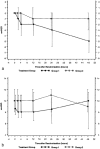Treatment with bovine surfactant in severe acute respiratory distress syndrome in children: a randomized multicenter study
- PMID: 12589529
- PMCID: PMC7095123
- DOI: 10.1007/s00134-003-1650-1
Treatment with bovine surfactant in severe acute respiratory distress syndrome in children: a randomized multicenter study
Abstract
Objective: To determine whether bovine surfactant given in cases of severe pediatric acute respiratory distress syndrome (ARDS) improves oxygenation.
Design: Single-center study with 19 patients, followed by a multicenter randomized comparison of surfactant with a standardized treatment algorithm. Primary endpoint PaO(2)/FIO(2) at 48 h, secondary endpoints: PaO(2)/FIO(2) at 2, 4, 12, and 24 h, survival, survival without rescue, days on ventilator, subgroups analyzed by analysis of variance to identify patients who might benefit from surfactant.
Setting: Multicenter study in 19 reference centers for ARDS.
Patients: Children after the 44th postconceptional week and under 14 years old, admitted for at least 4 h, ventilated for 12-120 h, and without heart failure or chronic lung disease. In the multicenter study 35 patients were recruited; 20 were randomized to the surfactant group and 15 to the nonsurfactant group. Decreasing recruitment of patients led to a preliminary end of this study.
Interventions: Administration of 100 mg/kg bovine surfactant intratracheally under continuous ventilation and PEEP, as soon as the PaO(2)/FIO(2) ratio dropped to less than 100 for 2 h (in the pilot study increments of 50 mg/kg as long as the PaO(2)/FIO(2) did not increase by 20%). A second equivalent dose within 48 h was permitted.
Results: In the pilot study the PaO(2)/FIO(2) increased by a mean of 100 at 48 h (n=19). A higher PaO(2)/FIO(2) ratio was observed in the surfactant group 2 h after the first dose (58 from baseline vs. 9), at 48 h there was a trend towards a higher ratio (38 from baseline vs. 22). The rate of rescue therapy was significantly lower in the surfactant group. Outcome criteria were not affected by a second surfactant dose (n=11). A significant difference in PaO(2)/FIO(2) in favor of surfactant at 48 h was found in the subgroup with an initial PaO(2)/FIO(2) ratio higher than 65 and in patients without pneumonia. CONCLUSIONS. Surfactant therapy in severe ARDS improves oxygenation immediately after administration. This improvement is sustained only in the subgroup of patients without pneumonia and that with an initial PaO(2)/FIO(2) ratio higher than 65
Figures






Similar articles
-
Improved oxygenation 24 hours after transition to airway pressure release ventilation or high-frequency oscillatory ventilation accurately discriminates survival in immunocompromised pediatric patients with acute respiratory distress syndrome*.Pediatr Crit Care Med. 2014 May;15(4):e147-56. doi: 10.1097/PCC.0000000000000069. Pediatr Crit Care Med. 2014. PMID: 24413319 Free PMC article.
-
Current definitions of acute lung injury and the acute respiratory distress syndrome do not reflect their true severity and outcome.Intensive Care Med. 1999 Sep;25(9):930-5. doi: 10.1007/s001340050984. Intensive Care Med. 1999. PMID: 10501747
-
Assessment of PaO₂/FiO₂ for stratification of patients with moderate and severe acute respiratory distress syndrome.BMJ Open. 2015 Mar 27;5(3):e006812. doi: 10.1136/bmjopen-2014-006812. BMJ Open. 2015. PMID: 25818272 Free PMC article. Clinical Trial.
-
Immunonutrition for acute respiratory distress syndrome (ARDS) in adults.Cochrane Database Syst Rev. 2019 Jan 24;1(1):CD012041. doi: 10.1002/14651858.CD012041.pub2. Cochrane Database Syst Rev. 2019. PMID: 30677127 Free PMC article.
-
Safety and efficacy of pulmonary surfactant therapy for acute respiratory distress syndrome in children: a systematic review and meta-analysis.BMC Pulm Med. 2025 May 21;25(1):250. doi: 10.1186/s12890-025-03728-4. BMC Pulm Med. 2025. PMID: 40399976 Free PMC article.
Cited by
-
A Master Protocol Template for Pediatric ARDS Studies.Respir Care. 2024 Sep 26;69(10):1284-1293. doi: 10.4187/respcare.11839. Respir Care. 2024. PMID: 38688543
-
Pediatric Acute Respiratory Distress Syndrome: Fibrosis versus Repair.Front Pediatr. 2016 Mar 30;4:28. doi: 10.3389/fped.2016.00028. eCollection 2016. Front Pediatr. 2016. PMID: 27066462 Free PMC article. Review.
-
Current status of severe acute respiratory syndrome in China.World J Gastroenterol. 2003 Aug;9(8):1635-45. doi: 10.3748/wjg.v9.i8.1635. World J Gastroenterol. 2003. PMID: 12918094 Free PMC article.
-
Hyperoxia treatment of TREK-1/TREK-2/TRAAK-deficient mice is associated with a reduction in surfactant proteins.Am J Physiol Lung Cell Mol Physiol. 2017 Dec 1;313(6):L1030-L1046. doi: 10.1152/ajplung.00121.2017. Epub 2017 Aug 24. Am J Physiol Lung Cell Mol Physiol. 2017. PMID: 28839101 Free PMC article.
-
Understanding the Functional Properties of Lipid Heterogeneity in Pulmonary Surfactant Monolayers at the Atomistic Level.Front Cell Dev Biol. 2020 Nov 16;8:581016. doi: 10.3389/fcell.2020.581016. eCollection 2020. Front Cell Dev Biol. 2020. PMID: 33304898 Free PMC article.
References
Publication types
MeSH terms
Substances
LinkOut - more resources
Full Text Sources
Medical

